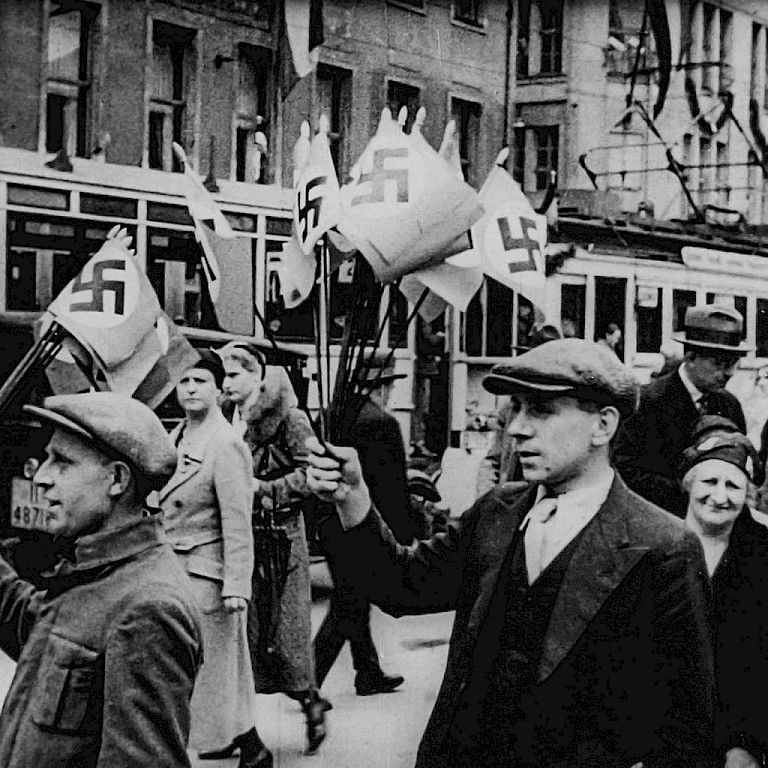
Szene aus dem Dokumentarfilm „Dresden ehrt die Arbeit": Zum „Feiertag der nationalen Arbeit und deutschen Volksfeiertag" beflaggte Schloßstraße. 1933
Foto: © SLUB / Deutsche Fotothek / Borchert, Christian
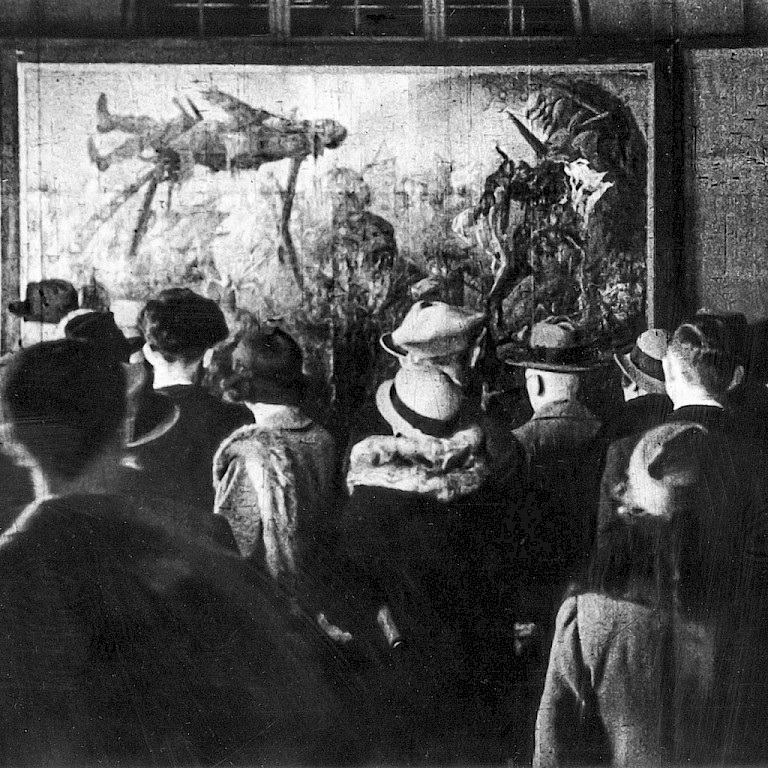
Szene aus dem Dokumentarfilm „Zeitdokumente: Ausstellung ,Entartete Kunst' im Lichthof des Dresdner Rathauses." Besucher der Ausstellung „Spiegelbilder des Verfalls in der Kunst" vor dem Gemälde „Der Schützengraben" von Otto Dix. 1933
Foto: © SLUB / Deutsche Fotothek / Borchert, Christian, VG BildKunst
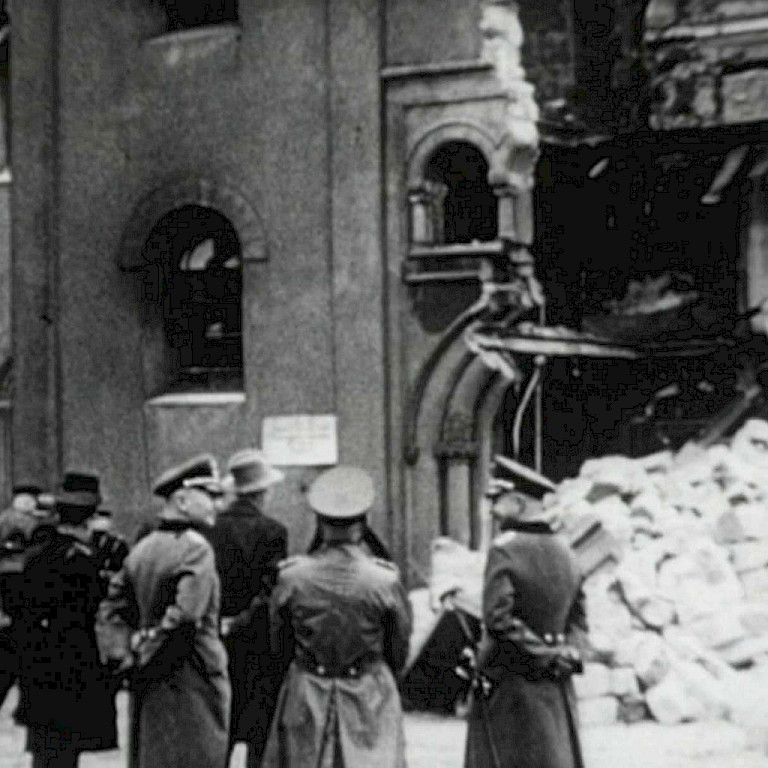
Abriss der Dresdner Synagoge. 1938. Filmstill
© Filmarchiv Hirsch-Film Dresden
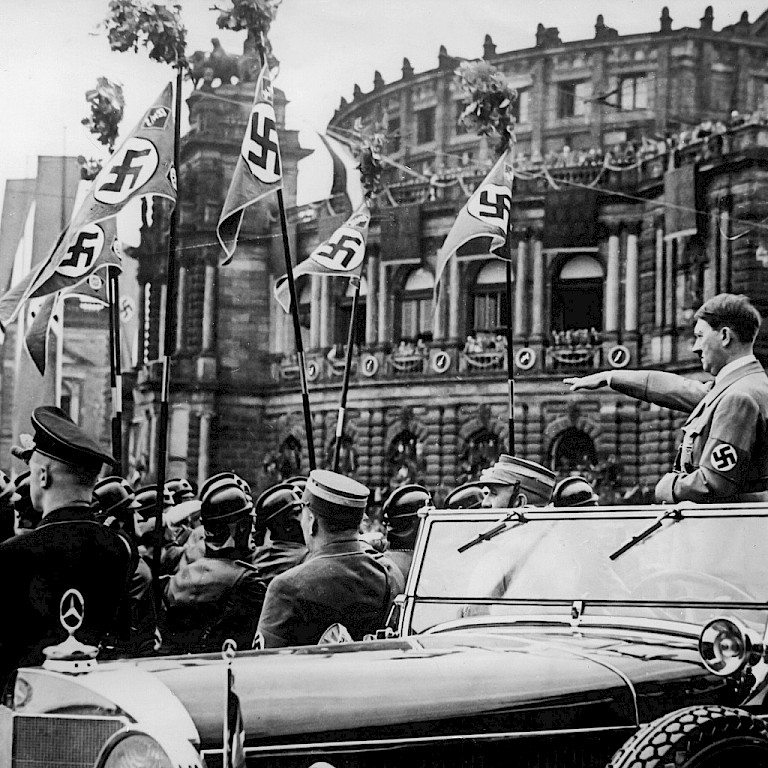
Adolf Hitler vor der Semperoper. 1934
Foto: ullstein bild
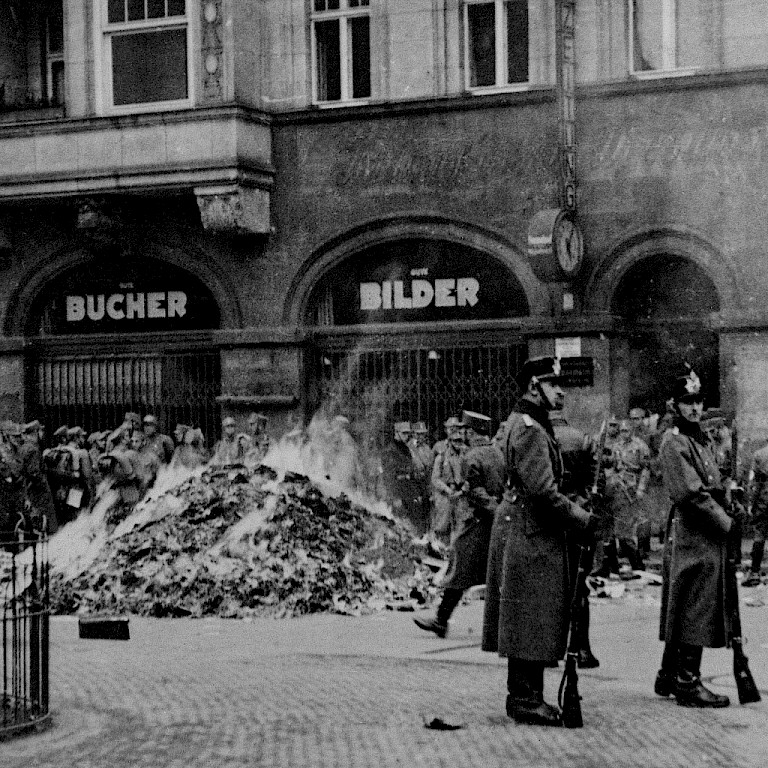
Die erste Dresdner Bücherverbrennung: SA-Männer verbrennen am 8. März 1933 unter dem Schutz der Polizei Akten und Bücher aus dem gestürmten Gebäude der Dresdner Volkszeitung und des Verlages Kader & Co. am Wettiner Platz. 1933
Foto: Museen der Stadt Dresden, SLUB/Deutsche Fotohek
Filmausschnitt: 1. Mai 1933, Tag der Arbeit, 1933
© Filmarchiv Hirsch-Film Dresden
06 TERROR INSIDE
This room is completely bathed in a red light. It is the red of the swastika flag, which was officially introduced as the new Reich flag on March the 13th 1933.
Emergency decrees were issued by the president of the Reich after the fire in Berlin’s Reichstag on the 27th of February 1933. These invalidated the significant civil rights of the Weimar Constitution. At the same time, they enabled the NSDAP to use state power to crush the opposition.
In Saxony alone, several thousand political opponents of the National Socialists, mainly Communists, Social Democrats, and trade unionists, were imprisoned in so-called protective custody camps. Abuse carried out by the SA guards was a common occurrence.
A further important step on the road to dictatorship was the process of national synchronisation, which began at the end of March 1933. Through this the German states were deprived of their political sovereignty and were governed from then on by so-called Reichsstatthalter. They acted as governors or proconsuls who had control over the state.
Martin Mutschmann served as Reich Governor of Saxony until 1945. He was a follower of Hitler and a fanatical anti-Semite who brutally attacked all those who conformed to the National Socialist’s enemy images. The book burnings in Dresden on the 7th and 8th of March 1933 were part of this increasing terror. Two months later, students from the Technical University of Dresden who supported the National Socialist’s, took part in a nationwide book burning. The works of Karl Marx, Kurt Tucholsky, Heinrich Mann, Erich Kästner and other well know authors fell victim to this event.
Historical photographs on the right of the four steles show how propaganda and national synchronisation was influencing public life in the city.
The discreditation by the National Socialists affected the entire field of art and culture: in September 1933 a Häme exhibition opened in the New Town Hall showing alleged “degenerate art”. Paintings, drawings and sculptures of modern Dresden Artists were publicly pilloried.
Violence and persecution were particularly directed against the Jewish people. Anti-Semitism was widespread in Germany, including Dresden, long before 1933; the Nazis took up anti-Semitism and turned it into a cruel terror.
It began with calls to boycott Jewish shops and the systematic deprivation of rights for Dresden’s Jewish population. The synagogue, designed by Gottfried Semper, was looted by SA men during the so-called Kristallnacht on the 9th of November 1938. It was then set on fire. A photograph shows the demolition of the ruins, for which the Jewish community had to pay.
In 1940, a forced resettlement to so-called Jewish houses took place. 1942 saw the start of the systematic deportations of the Jews to ghettos and concentration camps. There were approximately six million victims of the Holocaust – among them several thousand Jewish people from Dresden.
Through the photographs on the left of the stele, those persecuted under the Nazi regime are given a name, a face and a history. They are only a few. However, they represent the fate of countless victims of the National Socialist dictatorship.
Please take a moment to read these texts. They tell the story of Jenny Schaffer-Bernstein, a celebrated actress at the Dresden Theatre, whose career ended abruptly in 1933 – and later her life – under the National Socialist.
Or Fritz Busch, the star conductor and director of the Semper Opera House, who was threatened by SA people because of his political stance until he left Dresden.
With the systematic persecution, expulsion, and murder of thousands of Dresdner’s due to racist and political reasons, 1933 saw the beginning of an inner, mental destruction of Dresden leaving little more than an outer façade of the cultural city.
The next exhibition room deals with the expansion of the Nazi terror within the German war of aggression which resulted in the destruction of Dresden.